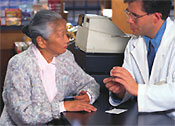
Resources for Medicare Beneficiaries: Navigating the Coverage Gap
How the Gap May Affect You

What is the Coverage Gap?
The coverage gap (sometimes called the “donut hole”) is when Medicare temporarily stops paying for your prescriptions and you have to pay the entire cost yourself. The coverage gap is only likely to affect about 8% of Medicare beneficiaries and only applies to those who have Medicare prescription drug coverage. You may see little or no impact from the coverage gap if:
Some drug companies offer financial assistance for their medicines. To apply for these programs, visit www.pparx.org, or call the Partnership for Prescription Assistance at 1-888-477-2669.
If you think you may be affected by the coverage gap, read on to find out more about how it works.
Planning Ahead: How the Coverage Gap May Affect You
All Medicare drug plans are not the same. When you join a Medicare drug plan, the plan sends you information about how the coverage gap works for that plan. Read this information carefully and call your plan if you have questions.
If you still have questions about your coverage, call your plan. You can also calll 1- 800-MEDICARE (1-800-633-4227); TTY users should call 1-877-486-2048.
You may be able to delay reaching the coverage gap by using lower-cost drugs covered by your plan; check with your health care provider to see if there are other medicines that will work for you. |
 |
Getting Into and Out of the Coverage Gap: How It Works
In a standard Medicare drug plan in 2007, you enter the coverage gap when the total amount spent on “covered drugs” by you and your plan combined reaches $2,400.?
Only covered drugs count toward getting you into – and out of – the coverage gap. Covered drugs are medicines for which your plan pays at least part of the cost at some time during the year.
Only certain kinds of expenses count toward the out-of-pocket limit.
It’s important to keep taking your medicines as prescribed during the coverage gap. You should never make changes like skipping doses, cutting pills in half, or stopping a medication without first talking to your health care provider. |
 |
? Does not include monthly premium (i.e., the amount you pay each month for coverage).
Keeping Track of Your Spending
You should always show your Medicare card at the pharmacy when you fill a prescription, even if you don’t think the plan will pay anything. It is also important to keep track of your spending for covered drugs so you know when you are coming close to entering and exiting the coverage gap.
Getting Help During the Gap
If you have high total drug costs and don’t have extra help during the coverage gap, consider switching to a plan that doesn’t have a coverage gap. You can switch plans between November 15 and December 31, 2007. If you switch plans during this time, your new coverage will start in January 2008. |
 |
Sample Expense Log
It’s important to track your spending to see when you will enter and exit the coverage gap. The sample expense log below shows you how.
Mary has Medicare prescription drug coverage for the seven medicines she takes every month. Her plan has a $265 deductible at the beginning of the year and Mary pays a copay for each of her prescriptions. Your plan may be different than Mary’s.

You can find out how much your plan paid by looking at your pharmacy receipt.
 The U.S. Department of Health and Human Services' Centers for Medicare & Medicaid Services has reviewed this publication, which is produced by YourPharmacyBenefit.org. YourPharmacyBenefit.org is a collaborative effort among non-profit organizations representing consumers, physicians, pharmacy, and pharmaceutical companies that strives to educate consumers to make informed decisions when choosing and using their pharmacy benefits, thus empowering them to access the medicines their health care providers prescribe. This publication may be reprinted for educational and nonprofit purposes.
The U.S. Department of Health and Human Services' Centers for Medicare & Medicaid Services has reviewed this publication, which is produced by YourPharmacyBenefit.org. YourPharmacyBenefit.org is a collaborative effort among non-profit organizations representing consumers, physicians, pharmacy, and pharmaceutical companies that strives to educate consumers to make informed decisions when choosing and using their pharmacy benefits, thus empowering them to access the medicines their health care providers prescribe. This publication may be reprinted for educational and nonprofit purposes.
To request additional copies of this booklet, write to:
Federal Citizen Information Center
Publication Number 653P
Pueblo, CO 81009
or go to www.pueblo.gsa.gov
YourPharmacyBenefit.org
1894 Preston White Drive
Reston, VA 20191
April 2007